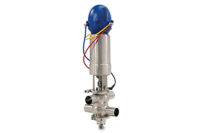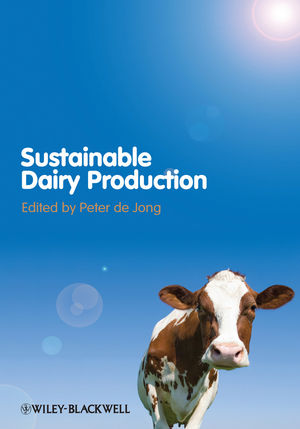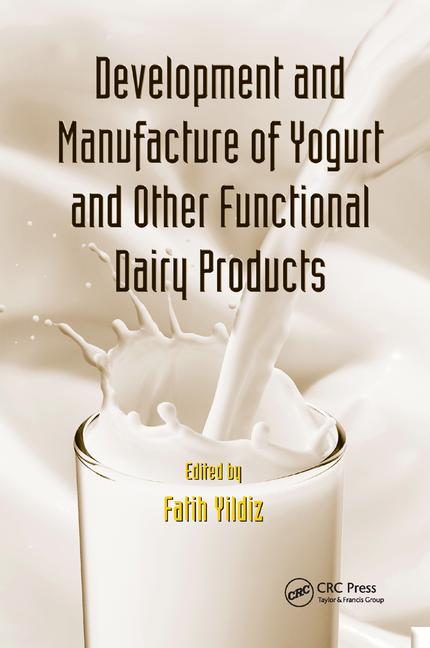Pump up dairy production with the right pumps and valves
Pumps and valves are vital parts of an efficient dairy processing operation, but identifying the most effective components can be tricky.

Though relatively small in stature, pumps and valves have a significant impact on efficient dairy processing. Incorporating the optimal pumps and valves is essential if processors are to minimize operating expenses while maintaining product quality.
“Designing a dairy processing system with the correct pumps and valves will save a lot of money over time due to higher efficiency and lower maintenance costs,” says David Kellin, applications engineer with Middleton, Wis.-based Fristam Pumps USA.
Selecting pumps that are the proper size for each application, for instance, helps processors avoid the use of larger-than-necessary motors, which will reduce power consumption and wear and tear while increasing component longevity, he states. The correct valves also will lower operating costs by minimizing unnecessary friction losses, Kellin adds.
Leveraging the appropriate pumps and valves also will minimize downtime, and the right valves “and well-thought-out logic” will allow the suitable amount of flow without wasted pressure loss, says Bob Garner, engineering manager for Glendale, Wis.-based Ampco Pumps Co.
The best pump and valve selections will vary in accordance with the dairy product’s characteristics and the placement of the equipment on processing lines, says Kevin Trauth, vice president of engineering for Rodem Inc., a Cincinnati-based pump and valve manufacturer.
Indeed, pumps may vary in size, type, and configuration in accordance with flow rates, pressure, viscosities, temperatures, and other variables, Kellin states.
“While a standard centrifugal pump may be perfect for pumping water-like fluids such as milk or for clean-in-place processes, processors may need a positive displacement pump to efficiently pump viscous products such as cheese curds, yogurt, or cottage cheese,” he says.

Photo credit: Photo courtesy of Rodem Inc.
A product’s stickiness and abrasiveness also can dictate the use of specific materials in a pump’s design, Kellin adds.
Centrifugal pumps have shaft-driven rotors, also called impellers, which rotate inside a casing. Applying centrifugal forces to liquids forces the liquid outside of the casing, where it exits through a discharge port. Positive displacement pumps transport liquids by trapping fixed amounts and then forcing the fluids into discharge pipes. Spindles that move in opposite directions start the movement.
Shear-sensitive fluids, which change viscosity when under stress or pressure, typically also require a positive displacement pump, while centrifugal pumps are best for higher flow rates, adds Steve Guskey, senior vice president of engineering for Chestertown, Md.-based Dixon Sanitary, a division of Dixon Valve and Coupling Co. LLC. He notes that valve selection will vary in accordance with product, pressure drop, clean-in-place (CIP) requirements, flow diversion needs, and hygienic or aseptic processes.
A deluge of designs
The twin-screw pump and mixproof valve are among the most flexible options for dairy processing, Trauth says. The twin-screw is a type of positive displacement pump and uses one or more screws to move fluids or solids along the screw axis. Mixproof valves enable the simultaneous flow of two distinct products or fluids through the same valve without risk of cross-contamination.
Twin-screw pumps can execute both process and CIP functions, eliminating the need for a separate CIP return pump and bypass line, along with the related valves and controls, Trauth says. The ability to change from very thin to very thick fluids with a single twin-screw pump also streamlines cleaning, boosts productivity, and enables processors to reduce the number of pumps in the plant, making maintenance easier, he states.
Vacuum pumps, meanwhile, which use little or no water, can allow dairy processors to generate major savings on water and disposal costs, says VJ Gupta, product marketing manager for Busch LLC, a Virginia Beach, Va.-based vacuum pump supplier.

Photo credit: Photo courtesy of Fristam Pumps USA
“Maintaining low operating costs is critical to ensuring optimum efficiency, especially for dairy processes that run continuously,” he states.
Vacuum pumps enable the removal of air and gas molecules from a sealed area and can operate in wet or dry variants in accordance with the products moving through the devices.
The use of pneumatic technologies can further decrease operating expenses, says Eileen Voges, product marketing manager for Emerson Fluid & Motion Control, a St. Louis-based provider of valves and pumps. She notes that the technologies have a lower initial cost than fully electric or motorized devices and can help plants save energy, shorten or reduce machine stops, and minimize unplanned downtime.
By equipping pneumatic devices with sensors, processors can monitor critical operating parameters — including temperature, pressure, flow rates, cycle times, valve response rates, air consumption, and energy use — in real-time, while identifying anomalies, Voges states.
“Using this information enables processors to address issues before they can become expensive problems,” she notes. “Without the proper technology, issues such as leaks can be difficult to detect and, left unaddressed, can cause massive energy losses or production slowdowns in processing systems.”
Cleanliness is a top concern
Pump and valve designs that enable effective sanitizing can further enhance efficiencies and reduce operating costs. Dairy processors, for instance, will save on labor expenses and downtime by using CIP systems that enable the cleaning of pumps and valves without having to manually remove components, Guskey says.
“The pump is usually one of the more complex parts of the production process to clean, so a hygienic pump design is essential to reducing cleaning of the entire system and, importantly, reduc[ing] the amount of cleaning agents needed,” adds Chuck Treutel, marketing and business development manager for the fluid technology group at Watson-Marlow Inc., a Falmouth, U.K.-based pump supplier.
By eliminating the need to disassemble equipment, CIP processes also can help reduce equipment damage, misplaced parts, or incorrect reassembly, Garner says.

Photo credit: Photo courtesy of Ampco Pumps Co.
It is vital, however, that the valve body and internal component materials are washdown compatible to handle the harsh, caustic detergents in CIP applications, Voges says. It also is important that such materials do not contaminate the product or alter its taste, which makes stainless steel an attractive option, she states. To further enhance food safety, the valve body should prevent the trapping of product in the valve itself, which could lead to the development of pathogens.
Pump and valve users also could reduce contamination threats by incorporating components with such materials as 316L stainless steel, chrome-oxide or silicon-carbide seal faces, and specific elastomers, Kellin says.
“These features, as well as other small design implementations, reduce or eliminate areas where bacteria could accumulate,” he states. “It ensures a complete and effective sanitization while maximizing component lifespan.”
Pumps with front-loading seals enable more effective cleaning as well by eliminating dead zones and tighter clearances where contamination tends to develop, Garner states, adding that effective designs also avert the trapping of sanitizing liquids inside pumps and valves.
In addition, operators will benefit from isolating the vacuum pump from the rest of the piping and interceptor tanks during CIP or the sanitization cycle, Gupta says.
“This allows plant operators the flexibility of choosing either wet or dry running vacuum pump technology without having to spend more on expensive stainless-steel equipment.”
Look beyond the price
Indeed, cost is typically a major consideration and challenge for processors seeking to leverage the most effective pumps and valves, Trauth says.

Photo credit: Photo courtesy of Watson-Marlow Inc.
“The newer technology that delivers greater flexibility and subsequent benefits long term often has a greater upfront cost,” he states.
Operators should consider total cost of ownership when evaluating pumps and valves, Trauth says, which includes the return on investment (ROI) from efficiency gains. With the optimal components, processors will “reap immeasurable benefits of increased throughput, improved cleaning, less maintenance time and expense, and decreased waste costs,” he notes.
Treutel agrees, stating that a “huge challenge for processors is justifying the initial capital costs of the pumps. If the ROI is not extremely fast, some producers will continue using less-effective pumps, which save money in the short term at the expense of the long-term benefits of using the correct pump for the job.”
In addition, it is important for processors to leverage technologies that maintain product quality while avoiding waste, Treutel says. That includes incorporating designs that allow for the careful handling of curds and whey when producing cheese, and the gentle treatment of yogurt to maintain that product’s smoothness and thickness, he states.
“Butter production is also a challenge, as most pump technologies cannot handle such high viscosities, so the butter is heated to reduce its viscosity and enable it to be pumped, and then quickly cooled again to prevent deterioration in quality,” Treutel says. “The heating and cooling process is both time- and energy-consuming with risk to final product quality, therefore creating additional costs to the dairy producers.”
Processors, therefore, should seek solutions that can support high-viscosity products such as butter without extra production steps, he states, noting that some pumps can transfer butter at fridge temperature with no loss in performance.
Meet with the manufacturers
Yet pinpointing the most advantageous technologies can be difficult for the many operators that are unaware of their system requirements and the tools that are available to meet those needs, Kellin says. Consultations with potential supplies can help ease the process.

Photo credit: Photo courtesy of Emerson Fluid & Motion Control
“Almost all pump and valve manufactures have technical specialists and engineers on staff who will help determine the best options to meet each specific need,” he states. “It makes it much easier to find the pumps and valves that are best suited to maximize efficiency and reduce costs.”
The optimal suppliers also will have the experience and portfolios to implement valve solutions that save energy and improve performance, Voges states.

Photo credit: Photo courtesy of Dixon Sanitary
“The partner should have smart technologies, demonstrate strong product reliability and take a proactive approach to the partnership,” she says.
Valve suppliers must recognize and adapt to their customers’ needs as well, which can include a focus on less downtime, maximum overall efficiency, and greater sustainability, Voges says.
Gupta adds that plant operators should insist that potential vacuum pump manufacturers demonstrate the expected energy and/or utility savings from their technologies and include an ROI analysis.
Indeed, suppliers that provide processors with the pumps and valves that best suit their systems will better enable the facilities to obtain major operational cost savings, says a spokesperson for Green Bay, Wis.-based equipment provider Hart Design & Manufacturing Inc.
As a result, it is important for dairy processors to consider such factors as operating conditions, process requirements, utility costs, and the availability and sophistication level of their operators and maintenance personnel when considering technologies, Garner states.
“Any number of companies can sell a pump or valve, but not everyone understands the impact of the equipment on overall production efficiency and the potential repercussions that the wrong pump or valve may have downstream,” Trauth says. “Collaborating with a firm that focuses on solutions and not making a quick sale can help with the long-term success of overall operations.”
Looking for a reprint of this article?
From high-res PDFs to custom plaques, order your copy today!









